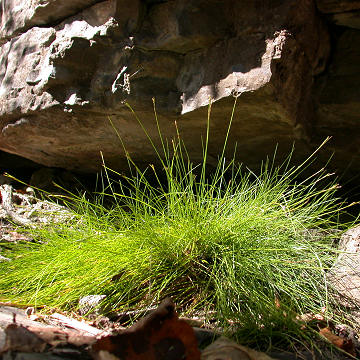

Carex eburnea - (image 1 of 3)
Taxonomy
Family: Cyperaceae
Section Albae
Habitat
Open calcareous woods, alvar, ledges.
Associates
Distribution
Newfoundland to British Columbia, south to VA, AL, NE, and TX.
Morphology
Densely tufted with long, slender rhizomes; stems thin, to 30 cm. Leaves shorter than stems, involute, to 0.5 mm; spikes subtended by short bladeless sheaths; pistillate spikes 2-3, 3-6 mm long, 2-6 flowered, on long erect peduncles exceeding the terminal staminate spikes; bracts of pistillate spikes bladeless, consisting of sheath only; pistillate scales ovate, shorter than perigynia, pale with a narrow green midvein; perigynium beakless, starting green and becoming dark brown, 1.5-2 mm, few-nerved, smooth, filled by the achene, with a conic beak 0.2 mm; staminate spike sessile; leaf blades under 2 mm wide, perigynia 1.5-2 mm, beakless; achene trigonous; stigmas 3; style deciduous.
Notes
Fruiting late May to July
Wetland indicator: FACU
The specific epithet mean "ivory", possibly in reference to the white-hyaline margins of the scales.
References
Gleason, Henry A. and A. Cronquist. 1991. Manual of Vascular Plants of
Northeastern United States and Adjacent Canada. Second Ed.
The New York Botanical Garden. Bronx, NY
Swink, F. and G. Wilhelm. 1994. Plants of the Chicago Region.
Indiana Academy of Science. The Morton Arboretum. Lisle, Illinois.
|
© Michael Hough 2010 |